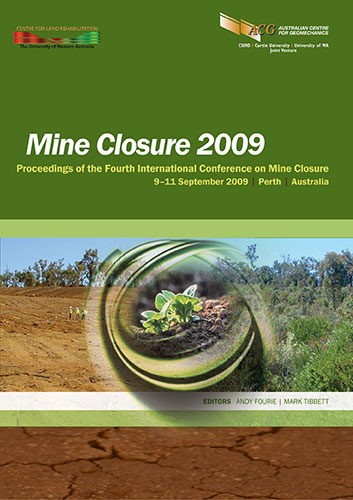Methods for simulating measured field responses for long-term performance of mine waste cover systems

|
Authors: Shurniak, RE; O'Kane, M |
DOI https://doi.org/10.36487/ACG_repo/908_36
Cite As:
Shurniak, RE & O'Kane, M 2009, 'Methods for simulating measured field responses for long-term performance of mine waste cover systems', in AB Fourie & M Tibbett (eds), Mine Closure 2009: Proceedings of the Fourth International Conference on Mine Closure, Australian Centre for Geomechanics, Perth, pp. 473-484, https://doi.org/10.36487/ACG_repo/908_36
Abstract:
Mine waste cover systems are typically a key component of mine closure plans. For this reason, and because cover systems generally encompass a large component of mine closure costs, it is critical that an acceptable level of risk in determining long-term cover system performance is achieved. Numerical simulations using computers are the most common tool used to evaluate the long-term water balance of mine waste cover systems. However, the accuracy of such simulations is dependent on the quality of data available to determine model inputs. The preferred method for ensuring the most representative model inputs are used is to simulate past performance of the cover using data generated from field performance monitoring, referred to as a field response model. The inputs from a model that provides a representative simulation of measured field responses can then be used as a basis for evaluating long-term mine waste cover system performance. Field response models attempt to recreate complexities of the real world in mathematical terms. Hence, all facets of a cover system’s water balance must be addressed in the model. This includes, but is not limited to, soil-plant-atmosphere interactions, evolution (weathering) of the cover layers, and heterogeneity (as well as layering) of materials. This paper presents the current methodology used by the authors to simulate these processes. In order to illustrate the methodology, results are presented for field response models developed at three sites situated in starkly contrasting climatic regimes: an arid to semi-arid site, a humid subtropical site, and a subarctic site. The examples show that following such a methodology can result in a highly accurate set of model inputs in almost any climatic region. Field response modelling is the most appropriate method of determining and validating a set of model inputs for a mine waste cover system. However, field response modelling requires the accurate prediction of complex soil-plant-atmosphere interaction with time. Hence, the modelling process requires many iterations before accurate estimates of field responses can be realised. The changes to the model made between iterations must be deliberate and documented to limit the number of iterations required to obtain calibration. This paper presents a methodology for cover system field response modelling that can be used to develop a calibrated field response model. The methodology is discussed, and examples of the application of the methodology are provided to illustrate the process. Application of this, or a similar methodology, is fundamental in developing a model that can be used as a basis for evaluating long-term cover system performance under a variety of conditions.
References:
Beven, K.J. and Binley, A.M. (1992) The future of distributed models; model calibration and uncertainty prediction,
Hydrological Processes, Vol. 6, pp. 279–298.
Beven, K.J. and Freer, J. (2001) Equifinality, data assimilation, and uncertainty estimation in mechanistic modelling of
complex environmental systems, Journal of Hydrology, Vol. 249, pp. 11–29.
Beven, K.J. (2006) A manifesto for the equifinality thesis, Journal of Hydrology, Vol. 320, pp. 18–36.
Daniel, D.E. (1983) Permeability Test for Unsaturated Soil, Geotechnical Testing Journal, Vol. 6, No. 2, pp. 81–86.
Durner, W. (1994) Hydraulic conductivity estimation for soils with heterogeneous pore structure, Water Resources
Research, Vol. 30, No. 2, pp. 211–223.
Eamus, D., Hatton, T., Cook, P. and Colvin, C. (2006) Ecohydrology, Vegetation Function, Water and Resource
Management, CSIRO Publishing.
Ebel, B.A. and Loague, K. (2006) Physics-based hydrologic-response simulation: Seeing through the fog of
equifinality, Hydrological Processes, Vol. 20, pp. 2887–2900.
Eching, S.O., Hopmans, J.W. and Wendroth, O. (1994) Unsaturated Hydraulic Conductivity from Transient Multistep
Outflow and Soil Water Pressure Data, Soil Science Society of America Journal, Vol. 58, pp. 687–695.
Fredlund, D.G. and Rahardjo, H. (1993) Soil Mechanics for Unsaturated Soils, John Wiley and Sons Inc., New York.
Fredlund, D.G. and Xing, A. (1994) Equations for the Soil-Water Characteristic Curve, Canadian Geotechnical Journal,
Vol. 31, pp. 521–532.
Methods for simulating measured field responses for long-term performance of mine waste R.E. Shurniak and M. O’Kane
cover systems
484 Mine Closure 2009, Perth, Australia
Fredlund, D.G., Xing, A. and Huang, S. (1994) Predicting the permeability function for unsaturated soils using the soil-
water characteristic curve, Canadian Geotechnical Journal, Vol. 31, pp. 533–546.
O’Kane, M. and Wels, C. (2003) Mine Waste Cover System Design – Linking Predicted Performance to Groundwater
and Surface Water Impacts, Sixth International Conference on Acid-Rock Drainage, Cairns, Australia, July.
Richards, S.J. and Weeks, L.V. (1953) Capillary Conductivity Values from Moisture Yield and Tension Measurements
in Soil Columns, Soil Science Society of America Proceedings, Vol. 17, No. 3, pp. 206–209.
van Genuchten, M.T. (1980) A Closed-form Equation for Predicting the Hydraulic Conductivity of Unsaturated Soils,
Soil Science Society of America Journal, Vol. 44, No. 5, pp. 892–898.
Watson, K.K. (1966) An Instantaneous Profile Method for Determining the Hydraulic Conductivity of Unsaturated
Porous Materials, Water Resources Research, Vol. 2, No. 4, pp. 709–715.
Weeks, L.V. and Richards, S.J. (1967) Soil-Water Properties Computed from Transient Flow Data, Soil Science Society
of America Proceedings, Vol. 31, No. 6, pp. 721–725.
© Copyright 2025, Australian Centre for Geomechanics (ACG), The University of Western Australia. All rights reserved.
View copyright/legal information
Please direct any queries or error reports to repository-acg@uwa.edu.au
View copyright/legal information
Please direct any queries or error reports to repository-acg@uwa.edu.au